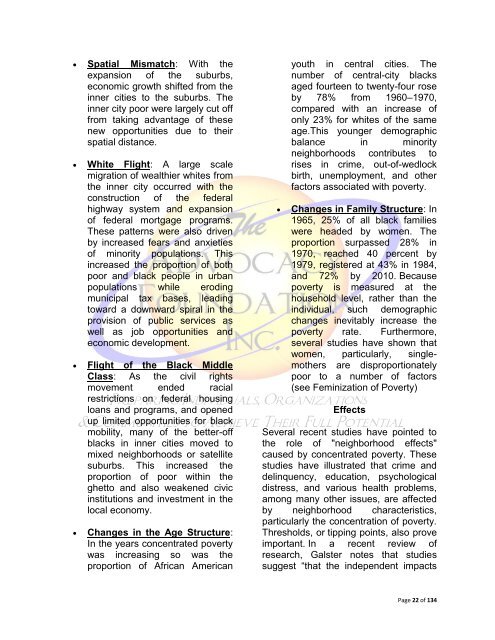Concentrated Poverty
Concentrated Poverty
Concentrated Poverty
You also want an ePaper? Increase the reach of your titles
YUMPU automatically turns print PDFs into web optimized ePapers that Google loves.
Spatial Mismatch: With the<br />
expansion of the suburbs,<br />
economic growth shifted from the<br />
inner cities to the suburbs. The<br />
inner city poor were largely cut off<br />
from taking advantage of these<br />
new opportunities due to their<br />
spatial distance.<br />
<br />
<br />
<br />
White Flight: A large scale<br />
migration of wealthier whites from<br />
the inner city occurred with the<br />
construction of the federal<br />
highway system and expansion<br />
of federal mortgage programs.<br />
These patterns were also driven<br />
by increased fears and anxieties<br />
of minority populations. This<br />
increased the proportion of both<br />
poor and black people in urban<br />
populations while eroding<br />
municipal tax bases, leading<br />
toward a downward spiral in the<br />
provision of public services as<br />
well as job opportunities and<br />
economic development.<br />
Flight of the Black Middle<br />
Class: As the civil rights<br />
movement ended racial<br />
restrictions on federal housing<br />
loans and programs, and opened<br />
up limited opportunities for black<br />
mobility, many of the better-off<br />
blacks in inner cities moved to<br />
mixed neighborhoods or satellite<br />
suburbs. This increased the<br />
proportion of poor within the<br />
ghetto and also weakened civic<br />
institutions and investment in the<br />
local economy.<br />
Changes in the Age Structure:<br />
In the years concentrated poverty<br />
was increasing so was the<br />
proportion of African American<br />
<br />
youth in central cities. The<br />
number of central-city blacks<br />
aged fourteen to twenty-four rose<br />
by 78% from 1960–1970,<br />
compared with an increase of<br />
only 23% for whites of the same<br />
age.This younger demographic<br />
balance in minority<br />
neighborhoods contributes to<br />
rises in crime, out-of-wedlock<br />
birth, unemployment, and other<br />
factors associated with poverty.<br />
Changes in Family Structure: In<br />
1965, 25% of all black families<br />
were headed by women. The<br />
proportion surpassed 28% in<br />
1970, reached 40 percent by<br />
1979, registered at 43% in 1984,<br />
and 72% by 2010. Because<br />
poverty is measured at the<br />
household level, rather than the<br />
individual, such demographic<br />
changes inevitably increase the<br />
poverty rate. Furthermore,<br />
several studies have shown that<br />
women, particularly, singlemothers<br />
are disproportionately<br />
poor to a number of factors<br />
(see Feminization of <strong>Poverty</strong>)<br />
Effects<br />
Several recent studies have pointed to<br />
the role of "neighborhood effects"<br />
caused by concentrated poverty. These<br />
studies have illustrated that crime and<br />
delinquency, education, psychological<br />
distress, and various health problems,<br />
among many other issues, are affected<br />
by neighborhood characteristics,<br />
particularly the concentration of poverty.<br />
Thresholds, or tipping points, also prove<br />
important. In a recent review of<br />
research, Galster notes that studies<br />
suggest “that the independent impacts<br />
Page 22 of 134

















